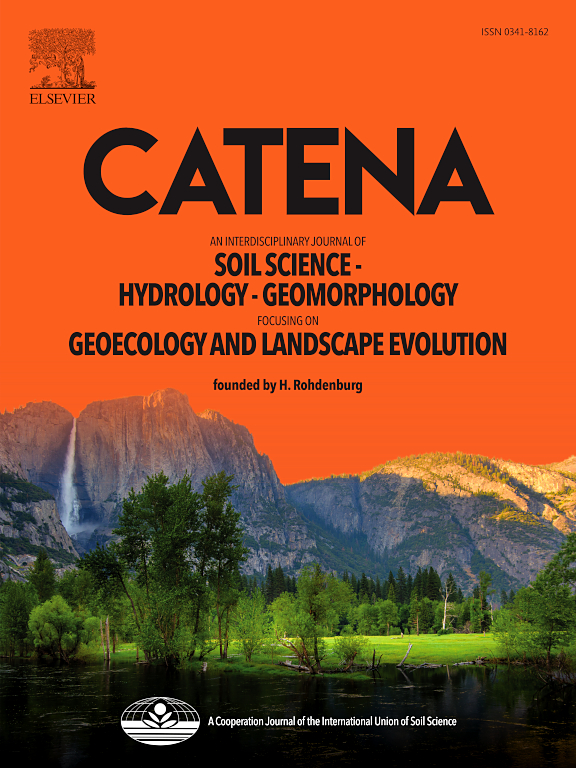Identifying the contrasting water uptake patterns of dominant afforestation species along an aridity gradient on the Chinese Loess Plateau using stable water isotopes
IF 5.4
1区 农林科学
Q1 GEOSCIENCES, MULTIDISCIPLINARY
引用次数: 0
Abstract
Inappropriate afforestation has caused severe soil desiccation and ecosystem degradation on the Chinese Loess Plateau (CLP) due to poor knowledge of plants’ water uptake patterns along the aridity gradient. In this study, the spatiotemporal difference of water uptake patterns by dominant afforestation species of tree (Robinia pseudoacacia), shrubs (e.g., Hippophae rhamnoides, Caragana microphylla, and Artemisia Ordosica) and natural grasses are explored by stable isotopes (δ13C, δ2H and δ18O). Results from the MixSIAR model showed that water uptake fractions from various soil layers changed from low to middle to high precipitation sites in the drier (2015) and wetter year (2016). The afforested shrubs derived the highest proportions of deep soil water at the low precipitation (LP) site, however, their root uptake depth remarkably shifted towards the shallow soil layers at the high precipitation (HP) site in 2015. In contrast, shallow soil water gradually became a dominant water source for tree and shrubs because of its higher shallow water availability during 2016. This changed root water uptake depth, indicating that the tested afforested tree and shrubs had a plastic ability to adapt their water uptake patterns in variable environments. In addition, results also showed natural grasses predominantly depended on the shallow soil water on the CLP despite the drier and wetter year. We observed significant differences in the relationship between δ13C values in the leaves of trees, shrubs, and grasses and annual precipitation. Specifically, the leaf carbon isotope (δ13C) values indicated that the tested trees and shrubs had a higher intrinsic water use efficiency (WUEi) for leaf-level water efficiency than grasses, implying that trees and shrubs presented a competitive advantage on water use over grasses on the CLP. This study also improved our understanding of spatial water usage strategies on CLP plantation species, which is essential to guide future selection of further plantation species selections and management in similar regions.
利用稳定水同位素识别黄土高原不同干旱梯度下优势造林树种的不同吸水模式
由于对植物在干旱梯度上的水分吸收规律认识不足,不合理的造林造成了黄土高原严重的土壤干旱化和生态系统退化。利用稳定同位素(δ13C、δ2H和δ18O)研究了优势造林树种刺槐(Robinia pseudoacacia)、沙棘(Hippophae rhamnoides)、小叶锦鸡儿(Caragana microphylla)和油蒿(Artemisia Ordosica)和天然禾草对水分吸收模式的时空差异。MixSIAR模型结果显示,在干旱年(2015年)和湿润年(2016年),各土层的吸水分数从低降水到中降水再到高降水。2015年低降水量(LP)立地灌丛吸收深层土壤水分的比例最高,而高降水量(HP)立地灌丛根系吸收深度明显向浅层土壤转移。相比之下,2016年,浅层土壤水因其较高的浅水有效性而逐渐成为乔灌木的主要水源。这改变了根系的吸水深度,表明被试树木和灌木在不同环境下具有适应其吸水模式的可塑性。此外,结果还表明,尽管年份较干或较湿,天然草在CLP上主要依赖浅层土壤水分。我们观察到树木、灌木和禾草叶片的δ13C值与年降水量的关系存在显著差异。叶片碳同位素(δ13C)值表明,乔灌木在叶片水分利用效率上的内在水分利用效率(WUEi)高于禾草,表明乔灌木在CLP上的水分利用比禾草具有竞争优势。本研究提高了我们对CLP人工林物种空间水分利用策略的认识,对今后类似地区人工林物种的选择和管理具有重要的指导意义。
本文章由计算机程序翻译,如有差异,请以英文原文为准。
求助全文
约1分钟内获得全文
求助全文
来源期刊

Catena
环境科学-地球科学综合
CiteScore
10.50
自引率
9.70%
发文量
816
审稿时长
54 days
期刊介绍:
Catena publishes papers describing original field and laboratory investigations and reviews on geoecology and landscape evolution with emphasis on interdisciplinary aspects of soil science, hydrology and geomorphology. It aims to disseminate new knowledge and foster better understanding of the physical environment, of evolutionary sequences that have resulted in past and current landscapes, and of the natural processes that are likely to determine the fate of our terrestrial environment.
Papers within any one of the above topics are welcome provided they are of sufficiently wide interest and relevance.
 求助内容:
求助内容: 应助结果提醒方式:
应助结果提醒方式:


